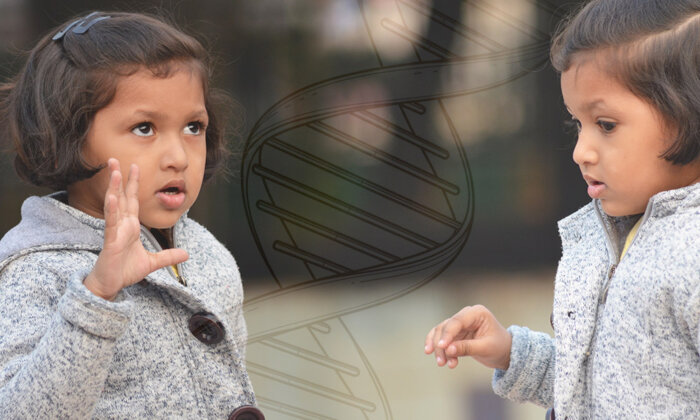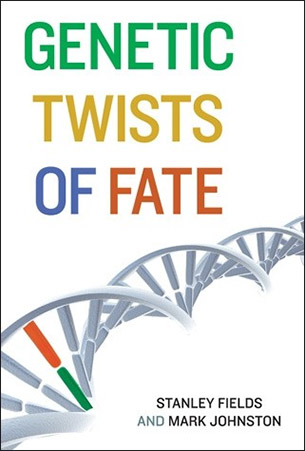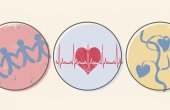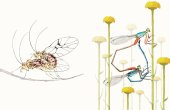Blaming Our Genes: The Heritability of Behavior

It’s easy to accept that human disorders such as phenylketonuria or cystic fibrosis or Huntington’s disease have a wholly genetic basis. And you likely have no problem believing that your risk of being afflicted with an illness such as heart disease, diabetes, or colon cancer is influenced by your personal DNA code. The question of heredity becomes more complicated, however, when we consider complex behaviors.
Is your chance of having a sunny disposition affected by your genes? How about if you are a pessimist — is pessimism an inherited trait? What if you’re an early-morning or a late-night person, or compulsively neat, or emotionally unable to connect with others — could genetic differences contribute to those traits? How much of our temperament is due to our genes? How much of our intelligence — our ability to learn and remember, to acquire language, to read and spell — is a function of our DNA code? And what about psychiatric disorders such as schizophrenia, bipolar disorder, and depression? Are those due to our circumstances, or to our genetic constitution?
The answer is: both. Nature and nurture, our genetic endowment and our life situation and experiences, determine our behavior. But we suspect that the contribution from genetics may be more than most of us imagine.
Consider, for example, Susan Middlebrook, of Colchester, Vermont. She usually gets seven or eight hours of sleep each night, but rather than going to bed at 11:30 p.m., after the late-night news, and getting up at around 7 a.m., Middlebrook goes to bed early, very early . . . like at 6:30 p.m. And between 1:30 and 3 a.m., just when you’re deep in your dreams, Middlebrook is raring to get up and go. “The net result is you can feel very isolated,” she told National Geographic News in 2005. “Who wants to party at three in the morning? Nobody I know, and I’m not headed to the local bar to see who’s there.” Instead, Middlebrook gets started on her morning chores long before your dreams are over.

Middlebrook suffers from familial advanced sleep phase syndrome (FASPS), the consequence of which is that her sleep patterns are way out of sync with the norm. To establish the norm, and the abnormal exceptions, sleep researchers ask people a series of questions about their sleep habits: At what time of day do you feel your best? How easy is it for you to get up in the morning? At what time would you go to bed if you were completely free to plan your day? At what time in the evening do you feel drowsy and begin to doze? Do you consider yourself a “morning” or an “evening” person? (The questionnaire was developed by a British scientist, James Horne, and a Swedish scientist, Olov Östberg.) Answers to these and other questions produce a score that lies on a scale running from extreme “eveningness” to extreme “morningness”; most of us fall somewhere in the middle of a broad bell-shaped curve of scores, but FASPS patients lie at the far “morningness” end of the scale, scoring higher than more than 99 percent of other respondents.
What makes Middlebrook’s syndrome so interesting is that it’s the result of an abnormality in her biological clock, known as the circadian rhythm; (“circadian” means, literally, the cycle of one complete day, from the Latin circa-, “cycle,” and dies, “day”). This circadian clock controls not just sleeping and waking but also metabolic, physiological and behavioral processes such as heart rate, hormone levels, blood pressure, mood, and alertness. Our biological clocks are reset each day by exposure to sunlight, thus keeping us in synchrony with our surroundings. But Middlebrook’s internal clock runs on a faster cycle, advanced by about four hours relative to most everyone else’s, so that she is ready for bed when her neighbors are ready to sit down to dinner.
Middlebrook’s sleep-wake cycle may seem unusual to you — it is far outside the statistical norm — but around the Middlebrook home it’s about as unusual as oatmeal for breakfast: two of her three sisters, one of her parents, and her own child all keep the same odd hours. This syndrome is clearly due to a variation present in the personal DNA code of these family members (the word “familial” in the name of the syndrome might have tipped you off to this), and not to any environmental cause.
Middlebrook’s sleep-wake cycle may seem unusual to you, but two of her three sisters, one of her parents, and her own child all keep the same odd hours.
Although FASPS affects only about three people in one thousand, its genetic basis was well worth deciphering. Findings about this syndrome may help to explain other more common sleeping disorders such as insomnia and narcolepsy, or lead to treatments for jet lag or seasonal affective disorder (SAD, in which the moods of sufferers are strongly affected by lack of sunlight in the winter), and they may provide health support and guidance for millions of workers who work the nightshift. Understanding human circadian rhythms may even enable drug treatments to be timed for better effect, or suggest ways to reduce nighttime auto accidents.
Now consider Jean, a 24-year old nurse who became obsessed with cleaning and washing. As related by Peter McGuffin and David Mawson, two psychiatrists in London to whom Jean was eventually referred, each day she would wash her hands 60 to 80 times and spend 12 hours disinfecting her house; she went through twenty liters of disinfectant a week. She made her husband stop his sports activity because it brought dirt into the house, and she gave up sexual activity because it could cause contamination. When Jean was admitted to the hospital, her hands were “roughened, red, cracked and bleeding” from the constant washing.
Jean’s identical twin, Jill, a social worker, lived apart from her sister and rarely saw her. Yet at the age of 22, Jill began displaying behavior similar to Jean’s. As soon as a meal was over she felt compelled to immediately wash the dishes and silverware, or else she would become severely anxious. Moreover, “the washing of the dishes and utensils had to proceed in a specific order, and failure to comply with the routine, or an attempt by others to relieve her of the task, provoked great discomfort.” Jill established other washing rituals, and despite her best efforts to stop carrying them out, she spent increasing amounts of time on them, to the detriment of her social life and her work.
Both twins had normal childhoods, had been outgoing children, and were academically accomplished. None of their family members had received treatment for a psychiatric disorder, although their father was “fastidiously neat and orderly in his habits.” The twins attended different universities; Jean obtained a degree in physics, Jill in history. Neither of them displayed any signs of mental illness before their obsessive-compulsive behaviors began. In fact, each of them learned of the other’s similar problem only after Jean began treatment with the drug clomipramine, which together with behavior therapy alleviated her symptoms enough to allow her to return to nursing. Jill was not treated, but experienced a spontaneous remission of her symptoms after more than a year.
What caused these identical twins to develop a similar disorder at a similar time in their lives? Was it something about the way their parents brought them up that led to their symptoms years later? Was it some food they ate, or some toxin they were exposed to as children? Or was it because their personal DNA code is identical, and some combination of variations in the genes they both inherited caused them to develop an obsessive-compulsive disorder in their early 20s? Or did the disorder develop because of a complex interplay of these factors?
Consider, finally, Lewis, the son of a well-to-do couple in Pittsburgh. Lewis looked perfect at birth and appeared to be developing normally. As detailed by his mother, at 18 months Lewis was almost saying words, but they weren’t the typical words that most toddlers begin with, such as “Mommy” and “Daddy.” Instead he babbled nonsensically. And he didn’t respond to the usual games that toddlers enjoy, such as peek-a-boo or ring-around-the-rosie. At two years of age, he had no interest in some toys but was obsessed with others, and when he played with these he was oblivious to everything going on around him. He loved to climb and to swing and to bounce on a trampoline, which he did without fear. Yet sometimes he was afraid to step off a rug onto a hardwood floor, reacting as if the next step would be off a cliff. At night, Lewis took off all his clothes and slept on the floor wrapped in a blanket and surrounded by toy soldiers and matchbox cars. Lewis also had tantrums, during which he lay on the floor screaming, unable to indicate his problem.
At three he had yet to acquire any language and had little interest in communicating with his family. He babbled only to his toy soldiers. His doctors were no longer able to dismiss his problems as simply those of a “difficult” child or one in the throes of the “terrible twos.” Lewis underwent a series of tests and the doctors concluded he had an autism spectrum disorder.
The diagnosis led to a variety of publicly and privately funded treatments, including speech and occupational therapy. Lewis made remarkable progress: He developed some language ability, and his behavior calmed down. He could hold his mother’s hand, play peek-a-boo with her and kiss her good night, and occasionally even make eye contact. When he read his favorite book, Eric Carle’s “The Very Hungry Caterpillar,” he said every word at the right time and mimicked the slurping sound of the caterpillar eating. But he still could not carry on a conversation. Lewis entered a special-education preschool class, with the hope and expectation that in a few years he could be integrated into a typical school class.
Autism is a complex developmental disorder that appears within the first three years of life. Its symptoms, which can range from mild to severe, are characterized by a lack of emotional contact with others, difficulty with verbal and nonverbal communication, and a restricted range of activities and interests. Children are born with autism or with the potential to develop it; they do not acquire the condition because of bad parenting. A fascinating feature of the chromosomes of some autistic children is that large chunks of DNA — millions or tens of millions of base-pairs — are found duplicated in some children and lost altogether in others. These regions can contain dozens of genes. The analysis of the personal DNA codes of these children may help pinpoint the specific genetic changes responsible for this complex and debilitating disease.
When a human population is measured for any characteristic, say height or weight, or blood pressure or cholesterol level, the measurements reveal a continuous spectrum between two extremes.
It’s no different for a complex behavior, such as how we deal with stress. Even very young babies display a broad range of responses, from those who cry easily to those who seem unbothered by almost any challenge. Similar patterns are observed in the extent or degree to which children are active or sedentary, whether they persist at pursuing a task or lose their focus, or the extent of their introversion or extroversion. Among adults, the amounts of alcohol, nicotine, or drugs that are consumed show the same broad distributions. Some part of these traits is likely due to genetics, and some is surely due to environmental components. But how much is due to each?
The measure of the amount of the genetic effect is termed “heritability.” A trait or behavior that is wholly due to genetics has 100 percent heritability; one that is wholly due to the environment has zero heritability.
The environmental component could be due to factors shared among family members, such as the home environment, the food preferences of the family, or the level of pollution in the town where the family resides. Or it could be due to factors that are not shared, such as the specific set of friends or teachers of each family member, or unusual life events such as accidents, or diseases unique to each individual.
How do we measure, or quantify, heritability? It’s actually pretty easy. All that is needed is a set of individuals whose genetic relatedness is known, and a measurement of some trait or condition for each individual.
The easiest of these studies to understand exploits the genetic similarity of twins. The personal DNA codes of identical twins are identical, because they develop from a single fertilized egg. That is, the DNA sequence of each gene in one twin is identical to its sequence in the other twin. Fraternal twins also shared the same womb at the same time, but have the same version of only about half of their genes (like any siblings), so the genetic contribution to a trait is twice as great in identical twins as it is in fraternal twins. Thus, the more similar a trait is in identical twins as compared to fraternal ones, the greater the genetic contribution to it is likely to be.
A large number of studies suggest a heritability for intelligence of around 50 percent; some studies put this number at greater than 80 percent.
Another type of study compares siblings from the same parents (who have the same version of about half of their genes), to adopted siblings who are not genetically related but share the same surroundings. A genetic influence on a trait is apparent when biological siblings are more similar than adopted ones; an environmental influence is obvious when adopted and thus genetically unrelated siblings resemble each other more than they do other unrelated people who grew up in other families.
A third type of analysis uses family genetic studies that compare how often a disease occurs in a family in which one member is known to be affected to how often it occurs in the general population. Diseases with a genetic basis occur more frequently in members of a family that has one case — in other words, genetic diseases run in families.
With these ways to quantify heritability, let’s examine some human traits. We’ll start with intelligence — a particularly thorny issue. We’d like to believe that a roomful of books, Mozart playing in the background, and a nurturing set of parents will put any infant on the road to a Nobel Prize. Those conditions can’t hurt, but they can only do so much: A large number of studies suggest a heritability for intelligence of around 50 percent; some studies put this number at greater than 80 percent.
A Swedish twin registry has information on 25,000 same-sex twins born over a period of about 70 years. Nancy Pedersen and her colleagues at the Karolinska Institute in Stockholm studied about 300 of these twin pairs, including identical twins reared apart, identical twins reared together, fraternal twins reared apart, and fraternal twins reared together. They found that intelligence scores of identical twins who grew up apart (most having been separated by the time they were two years old) correlated much more closely than the intelligence scores of fraternal twins who grew up in the same home.
Another study, the Texas Adoption Project, followed about 300 children who were adopted within a few days of birth and grew up entirely with their adopted families. John Loehlin and his coworkers at the University of Texas at Austin looked at results of intelligence tests given to the children at age seven and at age 17, to their adoptive parents, and to their biological mothers. The test scores of the biological mothers correlated significantly with those of their children who had been given away for adoption 17 years earlier, whereas there was no correlation between intelligence scores of the children and their adoptive parents. The researchers estimated that 78 percent of intelligence is inherited.
Addictive behavior, or the predilection to become addicted, is another trait whose heritability is controversial. Addiction includes physical dependence and symptoms of craving after chronic substance use, as well as behavioral dependence — the inability to stop an activity even though the consequences are severe. Alcohol, tobacco, and illicit drug use is estimated to contribute to one in eight deaths worldwide.
Yet most people who try habit-forming substances do not become addicted. One study estimates that the probability that someone who tries a substance once will become dependent on it ranges from about one in three or four for tobacco and heroin to about one in six or seven for cocaine and alcohol to about one in 11 for marijuana. The effect of genetics on the vulnerability of individuals to becoming addicted to these substances varies widely. Studies of twins suggest that persistent smoking and nicotine dependence is about 70 percent heritable, alcohol dependence is 50 to 60 percent heritable, and addiction to most other substances is 20 to 35 percent heritable. These studies also indicate that other disorders such as antisocial personality disorder and conduct disorder are often associated with addictive behavior.
Studies of twins suggest that persistent smoking and nicotine dependence is about 70 percent heritable, alcohol dependence is 50 to 60 percent heritable, and addiction to most other substances is 20 to 35 percent heritable.
Psychiatric disorders often have a large — sometimes, surprisingly large — genetic component. Schizophrenia, for which the lifetime risk is approximately 1 percent, has a heritability estimated at around 85 percent. Bipolar disorder (also known as manic-depressive illness because it is characterized by episodes of extreme elation (mania) alternating with episodes of depression) also has an individual lifetime risk of about one percent. Twin, sibling, and family studies all point to a strong genetic basis of bipolar disorder: a heritability of 80 to 90 percent. Depression (also known as unipolar disorder), for which we have an individual lifetime risk of around 10 to 20 percent in the United States, undoubtedly has a genetic basis: Its heritability may be as high as 70 percent.
Susan Middlebrook’s unusual sleep-wake cycle is obviously heritable. This syndrome has revealed something striking about circadian rhythms. Much of what’s known about these rhythms was originally worked out in Drosophila melanogaster, the tiny fruit fly that buzzes about the bananas left on a kitchen counter. Remarkably, the fly’s clockwork mechanism, the proteins it uses to reset its timing each day, works much like ours does. The first mutations to be identified that affect these rhythms, which caused flies to have either a shorter or a longer cycle, or no rhythmic cycle at all, were in a gene given the name period.
In 2001, Louis Ptácek, Ying-Hui Fu, and their colleagues at the University of Utah identified a human mutation that causes FASPS. It turned out to be in a gene that encodes a protein with an amino acid sequence very similar to the fly period protein, so the human gene was dubbed Period2. This was extraordinary evidence of gene conservation over hundreds of millions of years of evolution. Even stronger evidence came from the finding that the single amino acid change in the Period2 protein that advanced Susan Middlebrook’s clock corresponds to a mutation in fruit flies that advances the clock of that simple organism.
What about the heritability of obsessive-compulsive disorder, the illness that struck Jean and Jill? This disease, affecting about 2 percent of the population, has remarkably diverse symptoms but generally includes four major ones: obsessions and checking behavior; a need for symmetry and order; excessive washing; and hoarding tendencies. Individuals differ in their age of onset, the duration of the illness, and the types of symptoms they display. Many sufferers have tics, and some also have depression, phobias, separation anxiety, or disruptive behavior. Some are troubled by harmful sexual or religious obsessions, or by trichotillomania, compulsive hair pulling. Others may exhibit grooming behaviors.
This diversity of symptoms suggests that obsessive-compulsive disorder may exist in different forms that have different genetic causes — in other words, there may be multiple genetic routes to a group of disorders that have all been given a single name. So it is not surprising that twin studies almost always point to a substantial heritable component for this illness, ranging from 25 percent to 80 percent. Thus, the most probable explanation for Jean and Jill’s similar illnesses at similar ages is the young women’s genetic similarity, although other factors may have contributed to their condition.
Autism is a heart-breaking diagnosis for a parent to receive, and so it was for Lewis’s parents. The prevalence of autism went up more than five-fold in the 1990s, and now may be as high as 1 percent of children. Much of the increase may be due to broader diagnostic criteria and increased physician and parent awareness.
Numerous studies indicate that genetic factors are the main cause of autism. For example, siblings of an autistic child have about 10 times the risk of having the syndrome as the general population. A twin study in the United Kingdom yielded a heritability estimate of more than 90 percent for a broad set of autistic symptoms. Many genes are suspected of being involved in the syndrome. They haven’t been identified yet, but when they are, the diagnosis of autism, which can be difficult and often confusing, will be easier and more precise. Accurate and early diagnosis will also enable earlier intervention, which will greatly improve the prognosis for these children.
Estimating the genetic component of human behaviors and psychiatric disorders may help to remove a lingering stigma attached to people with mental illness — a misplaced sense that these are character flaws — and it may inspire more people to seek treatment. In addition, these studies all point to environmental components — generally still to be teased out — that interact with the genetic ones. That’s good news, since we have some control over the environmental inputs to disease. It is notable that even for the most heritable illnesses, such as schizophrenia or bipolar disorder, the heritability is never 100 percent, and even identical twins are never 100 percent concordant. Thus, even when genetics has a strong effect, it is not absolutely deterministic, so hope should never be abandoned. Finally, identification of the gene variants contributing to a disorder can assist and sharpen diagnosis, which will lead to earlier and possibly more effective treatments.
A high heritability does not imply that just a single gene is involved. In fact, for most of these disorders it is clear that many genes are involved, and no single gene is likely to explain most of the variability. By establishing a genetic basis for these disorders and identifying families that carry the causative changes in their DNA, geneticists can pinpoint the genes that are responsible.
Identification of such genes often leads to insight into the disease that can be tested in organisms suitable for experimentation, such as the fruit fly or the mouse. Analysis of those genes is sure to illuminate disease mechanisms. Just knowing what the relevant genes are will allow individuals to be tested for the gene variants that put them at risk of the disease, and, should they carry some of those variants in their personal DNA code, make them or their parents vigilant about early signs of the disease. And the genes and proteins that are implicated provide potential targets for new drugs that promise to improve the lives of people like Susan, Jean and Jill, Lewis, and many of the rest of us.
Stanley Fields is Professor of Genome Sciences and Medicine at the University of Washington and a Howard Hughes Medical Institute Investigator. Mark Johnston is Professor and Chair of the Department of Biochemistry and Molecular Genetics at the University of Colorado School of Medicine and Editor-in-Chief of the journal Genetics. Fields and Johnston are the authors of “Genetic Twists of Fate,” from which this article is excerpted.



